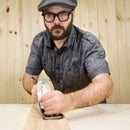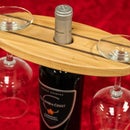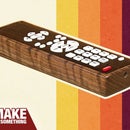Introduction: DIY Speaker Build
In this tutorial I'm making a set of stereo speakers to look like vintage guitar amps. I show you how to wrap the speakers with vinyl tolex, stretch the grill cloth and use corner protectors for a classic guitar amp vibe.
For even more details on this build visit my website. My YouTube channel also contains many more builds such as this. Enjoy!
Step 1: Cut All Pieces
I'll start by cutting up all the backs, fronts, tops, bottoms and sides to the proper dimensions.
Step 2: Speaker Hole Placement
I'll mark the placement of the woofers, tweeters and air tube being sure to stick with the exact placements as in the instructions.
Step 3: Drill Speaker Holes
I'll drill out what I can over on the drill press.
Step 4: Saw Woofer Opening
For the woofer opening I'll need to use my jig saw.
Step 5: Glue-up
Now it's time to glue up the cabinets. I'm just going to use some simple butt joints. The Rockler assembly squares clamped to the corners makes the process much easier. I'll add glue to all the joints and a pin nailer to secure it in place.
Step 6: Corner Reinforcement
In the corners I'm going to add some thin strips of plywood. This will add some reinforcement but more importantly will help align the back panel so it sits flush and the front so it's inset to allow our removable grill cover.
Step 7: Front Panel Assembly
The front panel just slides right in and rests on the thin strips of plywood. I'll then secure it in place with some pins.
Step 8: Grill Cover Assembly
For the grill covers I'm going to assemble everything with glue and clamp the pieces in place with tape. In a later step I'll stretch grill cloth over top.
Step 9: Round Over Edges
The corners of the cabinet all need to be rounded over so the corner protectors will sit flush.
Step 10: Tolexing
To attach the tolex to the cabinet I'll just brush some contact cement right on the plywood. You can let it dry for 10 minutes or you can use a heat gun to speed it up. Once it gets tacky I'll add a second coat and once again use a heat gun to speed up the drying process. I'll then use some spray adhesive on the back of the tolex. This creates almost an instant bond when attaching it to the cabinet. Don't worry though as the bond is not too strong yet and allows you to pull it off and reposition it if necessary.
Step 11: Tolex Seam
For the seam I'll overlap the tolex and use a straight edge to cut through both layers. Then remove each waste piece and this should form a perfect seam.
Step 12: Tolex Corners
The corner may seem a bit tricky but just cover everything with some contact cement and cut 45deg miters. I was a little sloppy with mine but the corner protectors we're going to add will cover that right up.
Step 13: Grill Cloth
For the grill cloth I'll then run a clamping call down the middle to be sure the cloth doesn't move on me. I'll then run some staples down the sides and back.
Step 14: Stereo Speaker Assembly
Next is to screw the speakers down, hot glue the air tube and Velcro the grill in place.
Step 15: Stereo Speaker Wiring
Follow the wiring diagram that came with the speakers and crimp everything in place. It's a pretty simple process and doesn't require any soldering.
Step 16: Poly-fil Speaker Cabinet
On the back panel I'll hot glue some Poly-fil that came with the kit. The subject of polly fill can be complex. Just know that it helps diffuse the wave forms inside the box for a better and bigger sound.
Step 17: Add Corner Protectors
And for the cherry on top I'll add the corner protectors and some rubber feet.
Step 18: And That's It!
Plug them in and turn it up! For more tutorials like this you can visit my website and be subscribe to my YouTube channel. Thanks!











